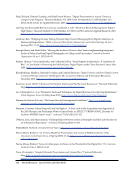60 · Survey Results: Survey Questions and Responses
Storage Challenges
17. Please briefly describe up to three challenge(s) your library has faced in storing born-digital
materials (e.g., amount of storage, security/ability to store sensitive data, ease of access to digital
materials in long-term storage, cost, technical skills in setting up and managing storage, etc.) and
how the library has addressed that challenge. N=57
Storage Challenges Word Cloud
Ability to store various kinds of data, ease of access to materials in long-term storage. We are working with an external
consultant to establish digital preservation services, including long-term storage.
Accessibility of electronic records: Because of our need to search and access a heterogeneous body of electronic records
at the individual asset level we needed a storage solution that supported indexing and searching for an array of formats.
EOP ERA uses the Hitachi Content Platform storage architecture, which indexes hundreds of file formats, including the
email and various office automation products that comprise the majority of the records in our holdings. Our deployment
of the Hitachi platform includes the FAST search engine, which allowed us to develop search interfaces that correspond
to the predominant types of records in our collections. Balancing ease of access with security. The amount of storage
necessary to ingest and reserve federal agency records and the cost for the massive amount of storage that will be
needed over the long haul.
Acquiring adequate volume of storage at a reasonable cost. Our A/V collections consume a large amount of space and
all our materials require security and redundancy. Tiered storage solutions would provide more cost-effective solutions,
however they are not available to us. We have materials in several locations and we do not have adequate means of
tracking what materials are stored where. The coordination to increase network security around sensitive dark storage
has been difficult. Miscommunication across four different groups for this new service has been a very slow process.
Administrative reorganization: Libraries is reliant on the university’s IT department (IST) to purchase and set up
digital storage. IST is undergoing a major reorganization making it very difficult for staff to be assigned to carry out
the Libraries’ requests for storage. A new CIO has been hired to finalize the reorganization process. Libraries has
investigated cloud storage as an alternative to IST. Size of digital files: the Archives has acquired several TBs of born-
digital records and has created several more through its ongoing digitization efforts. This fact, in combination with
IST’s difficulty in enabling additional storage, results in the Archives quickly exhausting existing storage options.
Storage Challenges
17. Please briefly describe up to three challenge(s) your library has faced in storing born-digital
materials (e.g., amount of storage, security/ability to store sensitive data, ease of access to digital
materials in long-term storage, cost, technical skills in setting up and managing storage, etc.) and
how the library has addressed that challenge. N=57
Storage Challenges Word Cloud
Ability to store various kinds of data, ease of access to materials in long-term storage. We are working with an external
consultant to establish digital preservation services, including long-term storage.
Accessibility of electronic records: Because of our need to search and access a heterogeneous body of electronic records
at the individual asset level we needed a storage solution that supported indexing and searching for an array of formats.
EOP ERA uses the Hitachi Content Platform storage architecture, which indexes hundreds of file formats, including the
email and various office automation products that comprise the majority of the records in our holdings. Our deployment
of the Hitachi platform includes the FAST search engine, which allowed us to develop search interfaces that correspond
to the predominant types of records in our collections. Balancing ease of access with security. The amount of storage
necessary to ingest and reserve federal agency records and the cost for the massive amount of storage that will be
needed over the long haul.
Acquiring adequate volume of storage at a reasonable cost. Our A/V collections consume a large amount of space and
all our materials require security and redundancy. Tiered storage solutions would provide more cost-effective solutions,
however they are not available to us. We have materials in several locations and we do not have adequate means of
tracking what materials are stored where. The coordination to increase network security around sensitive dark storage
has been difficult. Miscommunication across four different groups for this new service has been a very slow process.
Administrative reorganization: Libraries is reliant on the university’s IT department (IST) to purchase and set up
digital storage. IST is undergoing a major reorganization making it very difficult for staff to be assigned to carry out
the Libraries’ requests for storage. A new CIO has been hired to finalize the reorganization process. Libraries has
investigated cloud storage as an alternative to IST. Size of digital files: the Archives has acquired several TBs of born-
digital records and has created several more through its ongoing digitization efforts. This fact, in combination with
IST’s difficulty in enabling additional storage, results in the Archives quickly exhausting existing storage options.










































































































































































































